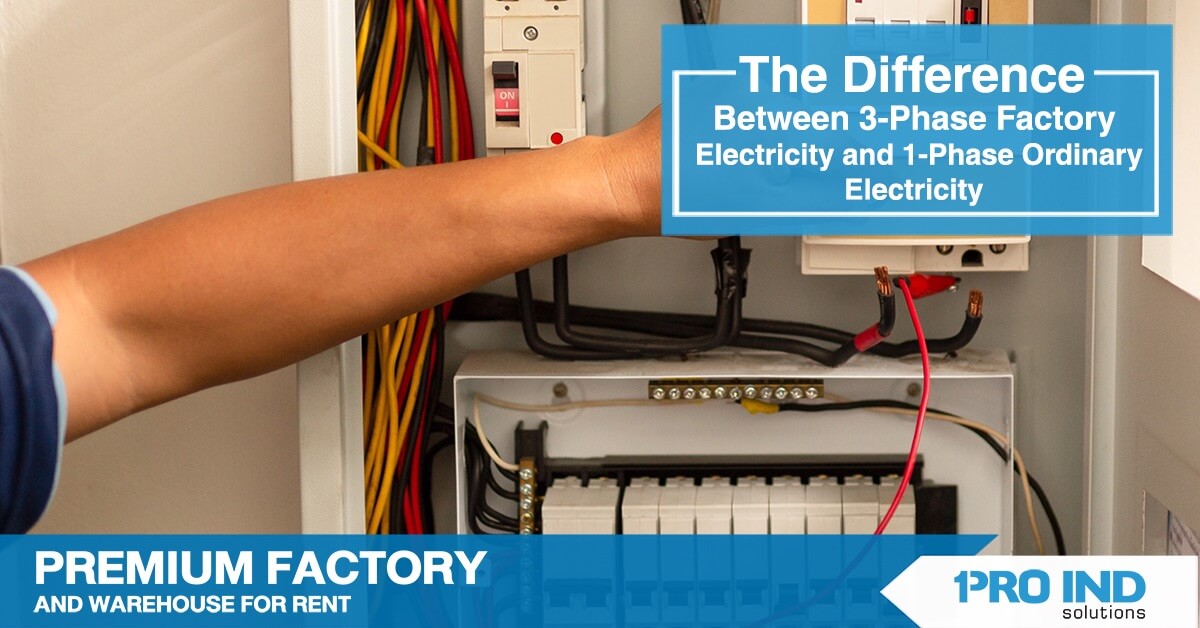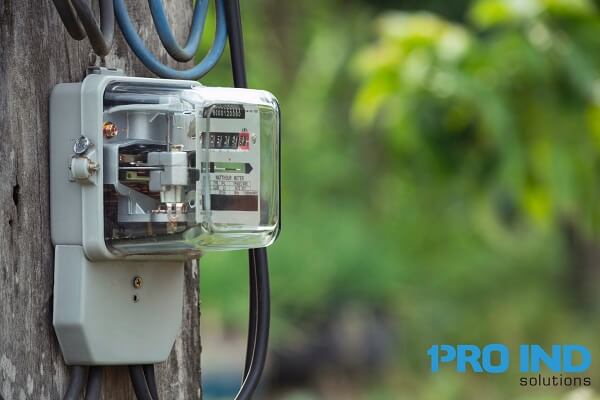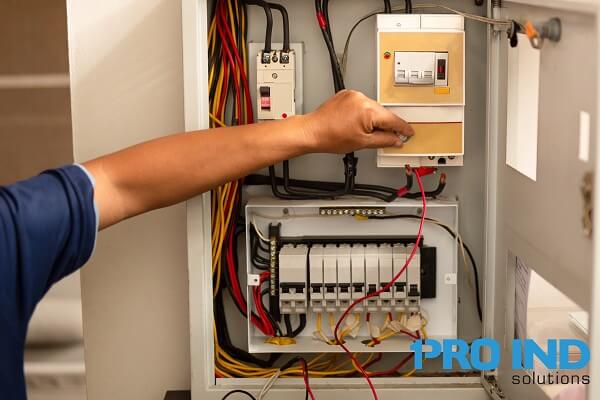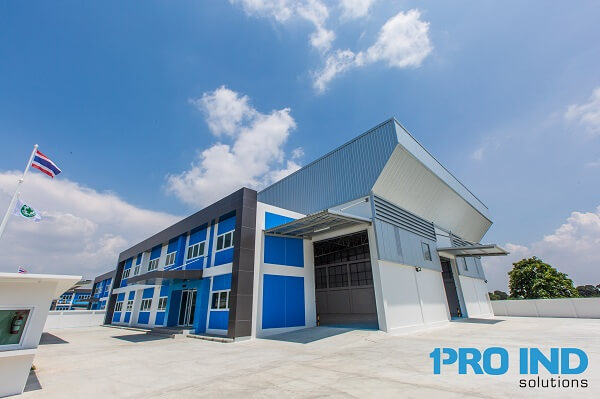The Difference between 3-Phase Factory Electricity and 1-Phase Ordinary Electricity

The Difference between 3-Phase Factory Electricity and 1-Phase Ordinary Electricity
What is the difference between 3-phase and 1-phase electrical systems? Which model is suitable for factory and warehouse applications. Typically, we are familiar with is the 1-phase power system for ordinary uses. In this article, we present the distinction between these two types and illustrates why the 3-phrase system is more suitable for industrial purposes. The utilization of electricity in factories and warehouses differs significantly from household electricity. Besides, specialized factories would demand different electrical designs, which are unique to their operations.
Here, we would briefly provide brief descriptions of these two distinct electrical systems. Also, we would explain why the 1-phrase electrical network is for household uses, while the 3-phrase system is for industrial applications.

The Difference between 3-Phase Factory Electricity and 1-Phase Ordinary Electricity
1-Phase Electrical System
For the electricity we commonly associate with, typically in our homes, we would come across the 1-phase power system. This system is sufficient for the electricity demands. When you inspect your lightbulbs and electrical appliances, you will notice they have two electrical wires and have a voltage of 220 volts.
This standard electrical connection processes two channels to provide electricity. The 1-phrase circuit would comprise of two wires: one current line(Current), and the neutral line (Neutral). These two wires are sufficient for domestic uses.
Sometimes, you may come across the third slot, which is the ground line (Ground). The third slot completes the circuit. When there is an electrical surge or leakage, this wire will route the excess current to the ground. This complete circuit offers safety for electrical uses in typical homes.
3-Phase Electrical Circuit

The 3-phase power system consists of 4 electrical wires and has a voltage of 380 volts. In this arrangement, three wires carry electrical current while the fourth is idle and has no electricity. We typically call the fourth wire the Neutral Line.
Most factories and warehouses employ 3-phase electrical systems because the demands of electricity in factories and warehouses are incredibly high. Whether heavy machines, cooling systems, or convoluted lighting systems, factories, and warehouses require a constant high-voltage supply of power.
Also, the installation of this system is more complex and hence more expensive. You have to evaluate its installation fees carefully. Another associated cost in this type is the application fees charged by relevant electric authorities. The 3-phrase system is more expensive to apply.
However, its crucial benefit is, in the long run, it saves more on electricity bills. On heavy electricity uses, the rates for this type of circuit is substantially lower than the 1-phrase system. Another benefit of this system is that you can still use 1-phrase appliances as well. Moreover, you can design the electrical system within your factory and warehouse more effectively. For example, usually, your office areas would require less power, and thus you can utilize the 1-phrase system in this area to save costs on the cables and installations. For factory and warehouse areas, the voltage demands are considerably higher, and you should utilize the 3-phrase system.
The 3-phase power system is a more cost-effective system when your operations rely on substantial electricity uses. Therefore, it is more fitting to utilize the 3-phase circuit for factory and warehouse purposes.
Hopefully, our comparisons would help you better understand the distinctions between these two systems. For factory and warehouse purposes, the 3-phrase system is the more viable choice. Although the initial costs associated with this circuit type are higher the single-phrase electricity, the overall electricity costs would be more economical in the long run. Furthermore, you can expect a constant supply of high-power electricity essential to your factory and warehouse uses.
If you are interested in renting a high-quality factory or warehouse in Thailand, please feel free to contact us anytime. Our rental factories and warehouses have 3-phrase electrical systems. Our projects are in an excellent location near Suvarnabhumi Airport, Burapha Withi Expressway, and the Motorway. Our tenants enjoy free repair services throughout the rental contracts. Also, we have a superb customer service team, who will help up with all essential issues, such as documents and license applications, factory modifications, machine placements, and utility applications. Our units are in high-security projects with 24-hour security guards and CCTV systems. Contact us for more information. Or, please follow the link below for further details.

Sources:
http://www.psptech.co.th/ความแตกต่างระบบไฟฟ้า-1-เฟส-และ-3-เฟส-16765.page
You might also like.
- 8 Things to Know About the Revised Thailand Factory Act The new Factory Act came into effect on October 27th, 2019. The government encouraged investment in the industrial sector...
- There are 8 Convincing Advantages of Renting a Factory or a Warehouse. When entrepreneurs establish their businesses or expand their operations, choosing the appropriate factory o...
- 8 Things to Consider in a Factory and Warehouse Rental Contract in Thailand Factory rental and Warehouse rental have become a prominent choice for business people today. Because of...
- Five innovations that PRO IND factories and warehouses for rent use for heat prevention. Global warming is getting worse every year, and Thailand is greatly affected. It has advers...
- There are 5 essential reasons why we should focus on heat prevention inside the factory and warehouse. The hot weather in Thailand does not seem to lessen. From statistics, the te...
- Five reasons examine why the Samut Prakan province did not flood when Thailand's Big Flood in 2011 occurred. When there was a big flood in 2011, Samut Prakan Province was virtual...
- 5 reasons why renting a factory or a warehouse in the Bangna-Trat area is an excellent idea for conducting your business in Thailand. Many people may wonder why they should rent fa...
- 4 Taxes Related to Factory Rentals and Warehouse Rental Currently, many entrepreneurs and business people are renting factories and warehouses for their business operations because...
- 6 Advantages of Setting up your Factory and Warehouse in Samut Prakan When deciding on the area to base your factory or warehouse, surely, Samut Prakarn would come up as one of the...
- 6 Factors in Choosing an Ideal Rental Factory or Warehouse for Your Business. We present six vital factors in determining the right factory or warehouse for your business. Picking ...
- 6 Things to Know about Establishing a GMP Food Factory in Thailand There are strict rules and standards imposed by the government and relevant authorities to adhere to the quality ...
- 5 Things you should Know Before Renting your First Warehouse. As your business prospers, you need substantial space to store your products and raw materials. Selecting your first w...
- 10 Features of Excellent Rental Factory and Warehouse Layouts Factory and warehouse layouts are critical to entrepreneurs and business owners' successes in their production. Rentin...
- 6 Advantages of uPVC Windows and Doors for Factory and Warehouse Many customers, who have visited our factory-and-warehouse-rental projects, are delighted with the quality of our d...
- 5 Typical Scams in Factory and Warehouse Rentals Recently, entrepreneurs and business owners are preferring to rent factories and warehouses rather than owning these properties the...
- 3 Benefits of Epoxy Floor Coatings for Factory and Warehouse. Epoxy floor coating is a synthetic rubber that is produced by the chemical reaction between Epoxy and Polyamine combin...
- 10 Effective Ways to Prevent Factory and Warehouse Fires The warehouse and factory buildings are essential to all types of operating businesses. Frequently, they are the businesses...
- 5 Practical Ways to Save Energy in your Rental Factory and Warehouse Modernized factories and warehouses nowadays are undergoing a drastic change: many factories and warehouses are...
- 7 Insights on Lean Management to Reduce Costs and Increase Profit for Factory Operators The lean system (LEAN) is an ideal practice for factory operations. It helps decrease avoida...
- 4 Advantages of PU Roofs for Rental Factory and Warehouse PU Foam insulation is an excellent material for omitting heat transfer into our rental factory and warehouse areas. It com...
- Key Points on Thailand's BOI: Clear Implications for Factory and Warehouse Operators Board of Investment of Thailand (BOI) has the core responsibility in promoting foreign direct i...
- 7 Benefits of Aluminum Composite, and Because of these Reasons, We use it for our Rental Warehouses and Factories. Presently, in the construction materials sector, we frequently no...
- 8 Significant Expenses Related to a Factory and Warehouse Rental in Thailand Renting a factory or a warehouse when you establish your company in a new country is a vital step in yo...
- 8 Questions to Ask When Choosing Warehouse for Rent in Thailand Selecting a suitable warehouse rental is imperative to business success. The current business landscape demands stra...
- Thailand’s Various Rental Warehouse Types and their Purposes This article would distinguish the various warehouse for rent types in Thailand. We can identify a warehouse facility a...
- 4 Safety Dimensions for Factory and Warehouse Operations In successful industrial enterprises, there are many factors that entrepreneurs and plant operators need to consider. Safet...
- Warehouse Management Techniques. How to Practice Warehousing Activities Efficiently for your Business? In manufacturing businesses, warehousing creates substantial financial impact...
- 5 Factors to Consider when Renting a Factory or Warehouse in Thailand Selecting a high-quality rental warehouse or factory is a fundamental step in a successful business establishm...
- 4 Necessary Steps for your Factory and Warehouse Relocation Factory and warehouse rentals have become the current viable choice for business operators because this choice offers ma...
- 5 Things to know about Thailand’s Cold StorageWarehouse for Rent A cold storage warehouse is a warehouse that controls the temperature in the storage area, and the appropriate temp...
- 5 Negotiation Tips for Thailand’s Factory and Warehouse Rental Contracts Selecting a factory and warehouse for rent is an integral part of your business success. In Thailand, succe...
- What are the Similarities and Differences Between the GMP and HACCP Standards in a Factory in Thailand? Two crucial, global standards for food manufacturers are the GMP and HACCP s...
- 7 Things to Know about Establishing a HACCP Manufacturing Facility in Thailand The HACCP system stands for Hazard Analysis and Critical Control Point System. Food production employ...
- 6 Highlights on Thailand’s Factory Clean Rooms Cleanrooms are an essential part of manufacturing sites, which demands high levels of cleanliness. The cleanrooms enable your product...
- 4 Insights on Thailand’s Bonded Warehouse Currently, rental bonded warehouses in Thailand have gained much popularity among business people. Bonded warehouses are especially useful...
- 3 steps to rent a factory and warehouse in Thailand and everything you should know to help you prepare when looking for factories for rent and warehouses for rent. Nowadays, factor...
- 7 crucial factors in choosing a factory and warehouse location in Thailand 7 crucial factors in selecting a rentalwarehouseor factory location in Thailand. This article is relevant...
- 5 things you need to know when choosing a factory for rent and a warehouse for rent in Thailand Quality factories or warehouses for rent can boost the tenant's company image and cr...
- 7 Advantages of Renting Warehouses in Pro Ind Warehouse Park 4 Project Renting a warehouse is a crucial step in managing business inventory, whether for small or large businesses....
- 8 Special Services When Renting a Factory, or Warehouse with Pro Ind Solutions Co., Ltd. At Pro Ind Solutions Co., Ltd., we prioritize the quality of our rental factories, and our ...
- 6 Advantages of Renting an Elevated Warehouse for Rent Choosing an efficient warehouse for rent is a crucial factor that significantly impacts the success of business operations to...


.png)
.png)

